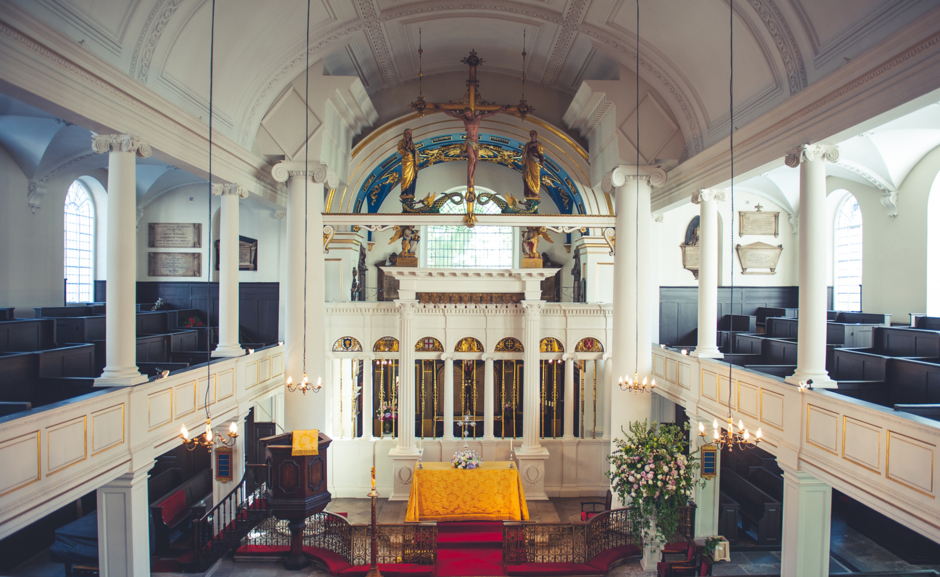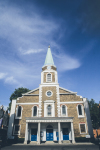
THIS WEEK
SUNDAY 28th July
11am Sung Eucharist -
The Ninth Sunday after Trinity
W.A.Mozart - Missa Brevis in
B flat K275
Gioachino Rossini -
O salutaris Hostia
J.S.Bach - Toccata in D minor
TUESDAY 30th July
1.10pm Mayfair Organ Concert
at St George’s
Matilda Johnston
(Royal Academy of Music)
Max Reger - Second Sonata in D minor op. 60: 1. Improvisation
Camille Saint-Saëns -
Fantasy in E flat major
Johann Sebastian Bach -
Prelude & Fugue in E minor
BWV 548
Louis Vierne - Scherzo & Finale
from the Second Organ Symphony op.20
WEDNESDAY 31st July
7.30am Morning Prayer
(online - www.facebook.com/
SUNDAY 4th August
11am Sung Eucharist - The Tenth Sunday after Trinity
W.A.Mozart - Missa Brevis in
B flat K275
Gioachino Rossini -
O salutaris Hostia
J.S.Bach - Toccata in D minor
CHAPEL OPENING TIMES
The Chapel is usually open to visitors Monday - Friday 8am to 3pm.
The Chapel is also open on
Saturdays for Occasional Offices, and
Sundays for the 11am Sung Eucharist.
ACCESSIBILITY
Step-free access to the Chapel is via a ramp through the main entrance. Please arrange in advance by contacting the Chapel office.
Audability: The Chapel's soundsystem is suitably fitted with
a loop system for pews directly
beneath the south gallery.
History
Beginnings
The foundation stone of the Grosvenor Chapel was laid on 7 April 1730 by Sir Richard Grosvenor, owner of the surrounding property, who had leased the site for 99 years at a peppercorn rent to a syndicate of four “undertakers” led by Benjamin Timbrell, a prosperous local builder. The simple classical form of the building, a plain rectangular box with two tiers of arched windows in the side walls, at the east a shallow projection for the communion table and at the west a portico over the pavement and a short spire containing a clock and bell to call the faithful to worship, is derived from recently completed churches such as James Gibbs’ St. Martin in the Fields or John James’ St. George’s Hanover Square. With the aid of these examples and the illustrations in numerous pattern books available at the time a competent builder like Timbrell, who had worked with Gibbs at St. Martin’s, could have produced the design for the Chapel without needing to commission an architect. The new building was completed and ready to use by April 1731.
The modest brick exterior contains an elegant white-painted interior flooded with light from clear-glazed windows. It is roofed with a plaster barrel vault, and over the original site of the communion table (now the Lady Chapel) is an elaborate composition showing the Holy Ghost in the form of a dove descending in glory. The galleries on three sides contain box pews with high sides similar to those which were originally provided throughout the ground floor also, and on the west gallery the royal Arms of George II show respect for the Defender of the Faith. The small but elegant oak organ case, provided by Abraham Jordan in 1732 at the expense of Sir Richard Grosvenor, contains an organ built in the Georgian style by William Drake of Buckfastleigh in 1990. Soon after the original 99-year lease ran out in 1829 the Chapel was brought within the parochial system as a chapel of ease to St. George’s Hanover Square. In 1841 the font, a white marble bowl set on a fluted pillar, was provided; and in 1877 the furnishings were brought up to date - a new altar table, now used in the Lady Chapel, was installed, the pulpit was moved from the middle to one side and reduced in height and the box pews were modified into the present lower benches.
Comper's development
But it is the transformation of the interior carried out by John Ninian Comper in 1912 which makes the building memorable today. With assurance and economy Comper converted a plain Georgian auditorium centred on the pulpit into a prayerful church in which attention is directed to the mystery of the altar. Behind a screen of Ionic columns the original sanctuary forms a Lady Chapel where the pedimented reredos remains, its panels once painted with the Ten Commandments, with the Creed and Lord’s Prayer at each side, and now covered by rich fabric. Here since 1921 the Blessed Sacrament has been reserved according to the old English manner in a hanging pyx borne by an angel appearing to have alighted through the clear glass of the east window.
In the body of the church Comper brought the iron Georgian communion rails forward to enclose a new sanctuary within which the High Altar stands against the screen. It is flanked by two Corinthian columns intended to carry a canopy which was never completed, and the giant Ionic columns at each side set the scale for colonnades which were to run the whole length of the building, replacing the gallery columns. They carry a beam on which stands the rood with the crucified Christ, attended by his Virgin Mother and the beloved disciple John, triumphing over the dragons of evil. Two angels kneel below with chalices to gather the sacred blood. The three delicate stained glass windows in the south wall are also by Comper two of which contain his trademark strawberry motif.
On the walls of the Chapel are tablets commemorating some of those buried in the vaults below. These include John Wilkes (1727-97), the “Friend of Liberty” and radical politician (tablet by John Flaxman); Lady Mary Wortley Montagu (1689-1762, notablet), the somewhat notorious continental traveller, author of poems, essays and letters and introducer of small pox inoculation to England in 1718; and the first Earl and Countess of Mornington, parents of the Duke of Wellington. The Duke himself and Florence Nightingale are amongst the notable people who worshipped here regularly during the last century, and Prince Albert attended a baptism in 1838.
Liberal Catholicism and Charles Gore
The provision made for Catholic worship within the Anglican tradition displayed in Comper’s arrangement of the interior was established by the Revd. H.R.L.Sheppard and maintained by his successors. It was firmly underpinned by the liberal Catholicism of Bishop Charles Gore (1853-1932) who assisted and preached here often during the last decade of his life. He had been the first Principal of Pusey House and subsequently Bishop in succession of Worcester, the new diocese of Birmingham, and Oxford, and may be regarded as one of the most influential Christian leaders and thinkers in England at the time.
Americans and other friends
During the Second World War men and women of the American armed forces were welcomed to the Chapel for their Sunday services, as recorded on a tablet outside the west wall, and after the War the congregation regularly included such people as the writer Rose Macaulay and Sir John Betjeman, Poet Laureate from 1972 until his death in 1984. The broadening of the Chapel’s appeal beyond the residents of Mayfair, begun in the time of Bishop Gore and extended by the Americans during the War, continues year by year as residents decline in number and people from other parts of London, joined by Christians from many nations, find here, on however temporary or permanent a basis, a congenial Anglican place of worship in central London. It retains its title of Chapel because it is not, and never has been a parish church, and its continuing existence is entirely dependent upon the generosity of those who worship here regularly or visit from time to time.
For an excellent history of the Chapel please see Ann Callender’s “Godly Mayfair” (ISBN 0 900644 03 6). This is available from the Chapel office, please contact us for details.

